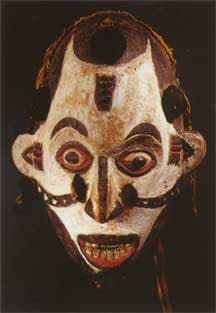Igbo Polychrome Agbogho Mmwo Mask, 20th Century CE
Wood
14
PF.3665 (LSO)
Pale masks such as this are said to represent spirits, and have a surprisingly wide distribution from the Gabonese F’ang to Nigerian tribes such as the Igbo, the makers of...
Pale masks such as this are said to represent spirits, and have a surprisingly wide distribution from the Gabonese F’ang to Nigerian tribes such as the Igbo, the makers of the current mask. It is a remarkable piece, with comparatively elongated jaw and heightened brows, and an exceptionally striking combination of black paint on a white background. The eyes are carved as a ringed protuberance, painted white, with black rims and pupils. The pointed nose is accentuated with a stripe of black paint, and the cheeks, eyebrows, lips, ears and a forehead keloid scarification have all received the same treatment. The detailing is excellent, with bared teeth, small triangular eminences in the cheek stripe and an extravagant multi-lobed hairstyle, also in black. Fragments of textile have also been used to heighten its fearsome appearance.
The Igbo (Ibo) of the Northern Niger River Delta are one of the largest and most important tribal groups in West Africa. They are culturally highly complex, with a political system based upon a loose form of chiefdom/kingship in some areas, and a democratic panel of decision-makers in others. Social life was usually governed by a number of secret societies. Their main god is Chukwu (literally “Great Spirit”), the creator of the world, who is also linked to the sun and all that grows and lives. Social conduct is governed by Ogu-na-Ofo, spirits who defend the innocent against unjust charges. If a guilty person appeals to them for help, they will be cursed by Amadioha (the god of thunder and lightning). There are numerous other gods that deal with issues as diverse as Ahia Njoku (yams) to Ikenga (fortune and industry) and Agwu (medicine men). Each person has a god named Chi, which is essentially an embodiment of a person’s fate.
The Igbo are known for their artistic diversity, due to the wide range of environments and local histories to which their culture is exposed. Standard sculpture includes Alusi figures – large, public figures designed to embody the spirits of significant gods – and also Ikenga figures, which are kept on personal altars in private homes. Masks are usually associated with initiation ceremonies and entertainment; the powerful appearance of this piece presumably had considerable resonance in the eyes of susceptible young initiates, which would justify its status as an instrument of social control. Equally, would have been a highly effective character in a dramatic masquerade.
This is a powerful and impressive piece of African art, and a worthy addition to any good collection of the genre.
The Igbo (Ibo) of the Northern Niger River Delta are one of the largest and most important tribal groups in West Africa. They are culturally highly complex, with a political system based upon a loose form of chiefdom/kingship in some areas, and a democratic panel of decision-makers in others. Social life was usually governed by a number of secret societies. Their main god is Chukwu (literally “Great Spirit”), the creator of the world, who is also linked to the sun and all that grows and lives. Social conduct is governed by Ogu-na-Ofo, spirits who defend the innocent against unjust charges. If a guilty person appeals to them for help, they will be cursed by Amadioha (the god of thunder and lightning). There are numerous other gods that deal with issues as diverse as Ahia Njoku (yams) to Ikenga (fortune and industry) and Agwu (medicine men). Each person has a god named Chi, which is essentially an embodiment of a person’s fate.
The Igbo are known for their artistic diversity, due to the wide range of environments and local histories to which their culture is exposed. Standard sculpture includes Alusi figures – large, public figures designed to embody the spirits of significant gods – and also Ikenga figures, which are kept on personal altars in private homes. Masks are usually associated with initiation ceremonies and entertainment; the powerful appearance of this piece presumably had considerable resonance in the eyes of susceptible young initiates, which would justify its status as an instrument of social control. Equally, would have been a highly effective character in a dramatic masquerade.
This is a powerful and impressive piece of African art, and a worthy addition to any good collection of the genre.
Literature
V19
